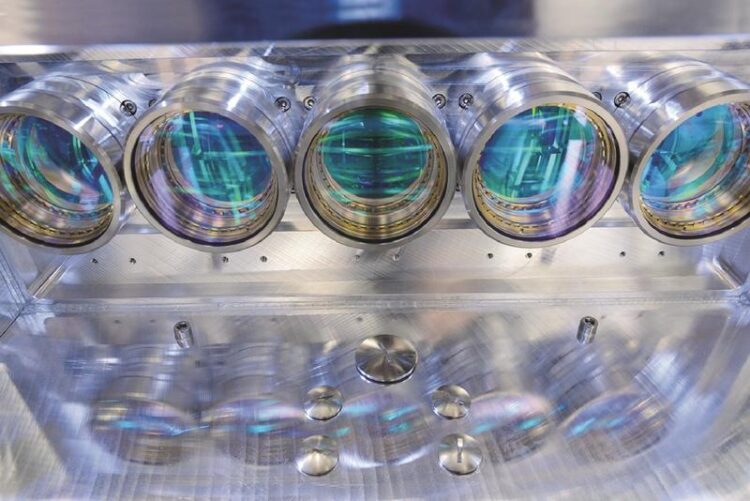Standardization of 3D Printing

Optical system of a multi-scanner LB-PBF system. Corresponding systems are to be monitored as part of the project.
© Fraunhofer ILT, Aachen, Germany
ASTM Awards Contract to Fraunhofer ILT.
The Fraunhofer Institute for Laser Technology ILT has received an award for decades of development in the field of additive manufacturing: The Aachen-based institute won a competition conducted by ASTM International and is now working on a project towards standardization of machine condition monitoring in laser beam powder bed fusion (LB-PBF). It is focusing on selecting and qualifying imaging sensor technology that can be used to specifically monitor the condition of LB-PBF systems. Finally, the institute will derive cost-reducing recommendations for end users from these data.

© Fraunhofer ILT, Aachen, Germany
Internationally unified standards simplify life for manufacturers and users of services and products. Often, the breakthrough of a new technology only comes when it is standardized because compliance with these standards inspires confidence among users. Since 2009, ASTM International – one of the leading international non-governmental standardization organizations for more than 120 years – has been leading the standardization of additive manufacturing in Committee F42. Additionally, ASTM International formed the Additive Manufacturing Center of Excellence (AM CoE) in 2018, as a cooperative partnership between ASTM and representatives from government, industry, and academia. AM CoE aims to accelerate AM standardization through conducting short-term and targeted R&D projects, as well as providing education and workforce development, certification, and advisory services.
Fraunhofer ILT expertise convinces AM CoE
Through the development of a new funding mechanism, so-called Call for Projects (CFP), ASTM allowed all organizations globally to submit proposals for addressing AM standardization gaps and receive support from ASTM. “Our outstanding expertise in LB-PBF is based on 25 years of development in additive manufacturing and today allows us to profitably combine expert knowledge with digital technologies,” explains Niklas Prätzsch, project manager in the Laser Powder Bed Fusion competence area at Fraunhofer ILT. “After the completion of the proposals evaluation by ASTM executive section on research and innovation (F42.90.05), we were selected as a new project partner.”
Standardizing and simplifying maintenance
Monitoring LB-PBF systems plays a very important role in the entire process because the high-precision, wear-sensitive and expensive optics of the corresponding systems place high demands on cleanliness: Very fine metal powder is used, and the optical systems can become contaminated during processing. They must, therefore, be regularly cleaned as a preventive measure. The increasing number of optical systems and the ever-higher laser powers used in LB-PBF have an aggravating effect. Prätzsch: “The load, probability of failure and maintenance effort of optical systems are increasing, while users still have to cope with maintenance guidelines based on little experience with previous system generations.”
The Aachen-based institute will be working until the end of 2021 on developing guidelines to standardize and simplify the maintenance and servicing of LB-PBF systems. “Manufacturers’ current maintenance guidelines are often still far too conservative. In contrast to long-established manufacturing technologies, there is no or only a comparatively small database available as a basis for making decisions whenever maintenance cycles need to be determined,” explains Prätzsch. For this reason, users replace components too early and increase operating costs because both unproductive downtimes and the consumption of spare parts increase.
Fraunhofer ILT is now focusing on selecting and qualifying imaging sensor technology for monitoring highly loaded optical systems of LB-PBF machines. In addition, it is deriving recommendations for end users of the technology. It aims to help end users independently assess the condition of optical systems and plan maintenance cycles by using improved information about the actual condition of the system. These cycles will then no longer be based on subjective perception or experience, but on real data. This means that maintenance is less likely to be carried out too early or too late, but rather closer to the right time. This should significantly reduce costs for the end user.
Data-based condition monitoring as a decision-making best practice
With the standardization, the Aachen engineers want to enable end users to easily and quickly generate their own database, making it easier for them to correctly classify and interpret the data. The goal is a standardized decision-making best-practice that recommends to the end user when and how to conduct maintenance or calibration. Prätzsch sums up: “We are providing end users with recommendations that simplify their use of cost-effective imaging sensor technology for condition monitoring of optical systems in LB-PBF systems. Based on the data, they can then make informed decisions about whether or not maintenance is necessary.” The goal is standardized condition monitoring that reduces the time previously spent on servicing and maintaining optical systems.
Profile: ASTM
It all started with a typical problem: Train rails frequently broke in the 19th century since the quality of the steel was inadequate. To improve quality, chemist Charles Benjamin Dudley, Ph. D., suggested founding ASTM International (originally the American Society for Testing and Materials) in 1898 to improve and standardize the quality of rail steels. This resulted in a leading international non-governmental standardization organization based in West Conshohocken, Pennsylvania (USA), which now has over 38,000 members from more than 140 countries. ASTM has contributed significantly to global standardization. There are currently more than 12,500 ASTM standards, which ensure standardized safety, quality and performance for numerous products and services. www.astm.org
Wissenschaftliche Ansprechpartner:
Niklas Prätzsch M.Sc.
Process and Systems Engineering Group
Laser Powder Bed Fusion Competence Area
Telephone: +49 241 8906-8174
niklas.praetzsch@ilt.fraunhofer.de
Jasmin Saewe M.Sc.
Head of the Laser Powder Bed Fusion Competence Area
Telephone: +49 241 8906-135
jasmin.saewe@ilt.fraunhofer.de
Weitere Informationen:
Media Contact
All latest news from the category: Machine Engineering
Machine engineering is one of Germany’s key industries. The importance of this segment has led to the creation of new university degree programs in fields such as production and logistics, process engineering, vehicle/automotive engineering, production engineering and aerospace engineering among others.
innovations-report offers informative reports and articles covering technologies such as automation, motion, power train, energy, conveyor, plastics, lightweight construction, logistics/warehousing, measurement systems, machine tools and control engineering.
Newest articles

Superradiant atoms could push the boundaries of how precisely time can be measured
Superradiant atoms can help us measure time more precisely than ever. In a new study, researchers from the University of Copenhagen present a new method for measuring the time interval,…

Ion thermoelectric conversion devices for near room temperature
The electrode sheet of the thermoelectric device consists of ionic hydrogel, which is sandwiched between the electrodes to form, and the Prussian blue on the electrode undergoes a redox reaction…

Zap Energy achieves 37-million-degree temperatures in a compact device
New publication reports record electron temperatures for a small-scale, sheared-flow-stabilized Z-pinch fusion device. In the nine decades since humans first produced fusion reactions, only a few fusion technologies have demonstrated…





















